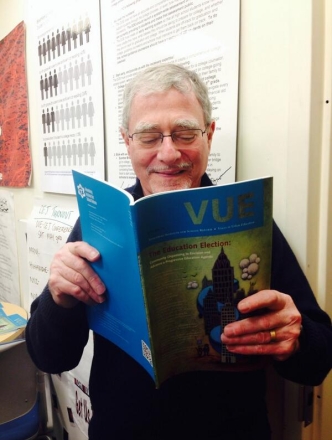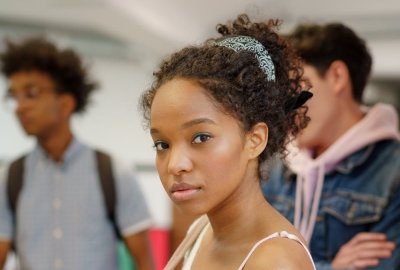
By Norm Fruchter and Christina Mokhtar-Ross
Our previous blog listed the fifty least diverse NYC high schools with the highest percentages of White and Asian students. To diversify those segregated schools, we proposed that the mayor remove all screening requirements for entry to all the city’s public high schools, and reserve 50% of all available high school seats for students who are economically disadvantaged or are served by Special Education programs. The other 50% of seats would be open to all students and selected through the current choice system. All high schools would be required, within a 5-year period, to transform their enrollment procedures so that 50% of their students reflect those required demographics.
The table below lists the fifty least diverse high schools with the highest percentages of Black and Latinx students. This blog compares the demographics and outcomes of both groups of segregated schools and suggests what might improve the academic quality of the least diverse Black and Latinx high schools. This is significant because our diversity proposals for the predominantly White and Asian schools would not significantly reduce segregation in the schools listed below.
| School | Black and Latinx students (%) | Special Education (%) | English Language Learners (%) | Economic Need Index (%) | Community School? | 4-Year College Readiness Index (without CAT) (%) |
|---|---|---|---|---|---|---|
|
Academy for Language and Technology |
100 |
5 |
67 |
Above 95% |
NO |
75 |
|
Gregorio Luperon High School for Science and Mathematics |
100 |
2 |
77 |
Above 95% |
NO |
49 |
|
Multicultural High School |
100 |
1 |
86 |
Above 95% |
YES |
8 |
|
Pan American International High School at Monroe |
100 |
1 |
87 |
Above 95% |
YES |
37 |
|
Manhattan Bridges High School |
99 |
5 |
36 |
93 |
NO |
73 |
|
Validus Preparatory Academy |
99 |
26 |
12 |
94 |
NO |
35 |
|
Pan American International High School |
99 |
2 |
77 |
Above 95% |
YES |
39 |
|
Bronx Leadership Academy II High School |
99 |
30 |
13 |
93 |
NO |
41 |
|
Careers in Sports High School |
98 |
27 |
16 |
93 |
YES |
33 |
|
Longwood Preparatory Academy |
98 |
30 |
16 |
92 |
YES |
29 |
|
Mott Hall Bronx High School |
98 |
24 |
9 |
93 |
NO |
52 |
|
Gotham Professional Arts Academy |
98 |
32 |
2 |
84 |
YES |
53 |
|
Brooklyn School for Music & Theatre |
98 |
21 |
3 |
84 |
NO |
37 |
|
DreamYard Preparatory School |
98 |
23 |
20 |
95 |
YES |
49 |
|
High School for Violin and Dance |
98 |
31 |
19 |
93 |
NO |
16 |
|
Bronx Design and Construction Academy |
98 |
37 |
9 |
90 |
NO |
41 |
|
The Metropolitan High School |
97 |
31 |
26 |
Above 95% |
YES |
23 |
|
Community School for Social Justice |
97 |
27 |
23 |
93 |
NO |
23 |
|
El Puente Academy for Peace and Justice |
97 |
23 |
23 |
91 |
NO |
41 |
|
East Williamsburg Scholars Academy |
97 |
15 |
34 |
89 |
NO |
30 |
|
Mott Haven Village Preparatory High School |
97 |
30 |
16 |
93 |
NO |
25 |
|
Alfred E. Smith Career and Technical Education High School |
97 |
27 |
17 |
90 |
NO |
67 |
|
Brooklyn Institute for Liberal Arts |
97 |
21 |
4 |
76 |
NO |
56 |
|
Kurt Hahn Expeditionary Learning School |
97 |
31 |
6 |
78 |
YES |
42 |
|
Urban Assembly School of Music and Art |
97 |
25 |
4 |
85 |
YES |
46 |
|
Frederick Douglass Academy VI High School |
97 |
24 |
32 |
91 |
NO |
19 |
|
Bronx Leadership Academy High School |
97 |
28 |
16 |
Above 95% |
YES |
23 |
|
Morris Academy for Collaborative Studies |
97 |
24 |
13 |
94 |
YES |
60 |
|
EBC High School for Public Service - Bushwick |
97 |
25 |
18 |
90 |
NO |
33 |
|
Inwood Early College for Health and Information Technology |
97 |
24 |
11 |
84 |
NO |
46 |
|
Frederick Douglass Academy III Secondary School |
97 |
28 |
18 |
93 |
YES |
46 |
|
Manhattan Academy for Arts & Language |
97 |
10 |
65 |
Above 95% |
NO |
48 |
|
High School for Law and Public Service |
97 |
26 |
36 |
92 |
NO |
20 |
|
The Urban Assembly School for Global Commerce |
97 |
33 |
11 |
94 |
NO |
39 |
|
High School for Health Careers and Sciences |
97 |
19 |
42 |
93 |
YES |
31 |
|
High School for Media and Communications |
96 |
18 |
48 |
92 |
YES |
18 |
|
The College Academy |
96 |
21 |
54 |
93 |
NO |
33 |
|
Explorations Academy H.S. |
96 |
26 |
23 |
93 |
NO |
28 |
|
Clara Barton High School |
96 |
17 |
7 |
76 |
NO |
46 |
|
Bronx High School for Law and Community Service |
96 |
23 |
12 |
89 |
NO |
80 |
|
Business of Sports School |
96 |
26 |
7 |
81 |
NO |
45 |
|
School for Excellence |
96 |
26 |
27 |
Above 95% |
YES |
16 |
|
Fordham Leadership Academy |
96 |
24 |
16 |
93 |
YES |
61 |
|
The Academy of Urban Planning and Engineering |
96 |
24 |
27 |
90 |
YES |
45 |
|
Performing Arts and Technology High School |
96 |
23 |
17 |
88 |
NO |
31 |
|
PROGRESS High School for Professional Careers |
96 |
22 |
22 |
91 |
NO |
30 |
|
Frederick Douglass Academy VII High School |
96 |
29 |
4 |
88 |
NO |
44 |
|
Wings Academy |
95 |
31 |
7 |
92 |
NO |
13 |
|
Bronx Envision Academy |
95 |
28 |
15 |
92 |
NO |
21 |
|
Brooklyn Collegiate: A College Board School |
95 |
24 |
6 |
84 |
YES |
49 |
Sources: NYC DOE. Demographic Snapshot, 2019-20
NYC DOE. 2019-20 School Quality Snapshot. (Admissions Method and College Readiness Index Data)
Notes: To maintain student privacy, schools with ENI values below 5% or above 95% have had their exact values replaced with "Below 5%" and "Above 95%" respectively.
9 predominately Black and Latinx schools had "Above 95%" as Economic Need Index (ENI) values. In calculating overall averages, we converted these values to 96%, thus the overall ENI average is likely to be higher.
4-Year College Readiness Index (CRI): This metric shows the percentage of students in the school’s four-year cohort who, by the August after their fourth year in high school, graduated with a Local Diploma or higher and met CUNY’s standards for college readiness in English and mathematics. The 2019-20 School Quality Reports and beyond will show the College Readiness Index (without the CUNY Assessment Test) and use that metric for report scoring. 2020 Regents waivers may affect metrics.
Comparing the two groups of segregated schools
The predominantly White and Asian schools are quite segregated, with an average of 66% combined White and Asian student population (compared to 31% citywide). The Black and Latinx schools are hyper-segregated, with an average combined population of 97% (compared to 66% citywide).


Students in the predominantly White and Asian schools have fewer students from economically disadvantaged homes, and who are assigned to Special Education or English language instruction. Students in the hyper-segregated Black and Latinx schools come from predominantly poor families and their schools have relatively high percentages of Special Education students and English Language Learners

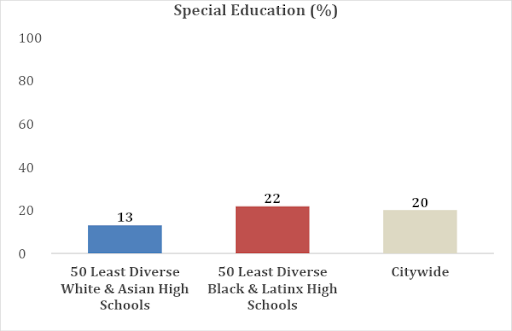
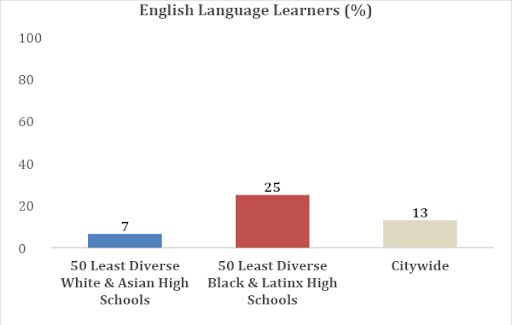
We used the NYC Department of Education’s College Readiness Index (CRI) to show the percentage of high school students graduating college-ready. (See the definition of the CRI in the table above). The analysis shows that 57% of the city’s students who completed their fourth year of high school met CRI standards in 2019-20.
The CRI dramatizes the differences between the two groups of segregated high schools. The fifty least diverse White and Asian high schools graduate almost all their students ready for college. The hyper-segregated least diverse Black and Latinx high schools graduate very few of their students as college-ready, which means that the great majority of their graduates are funneled into low-wage precarious jobs in the economy’s service sectors.
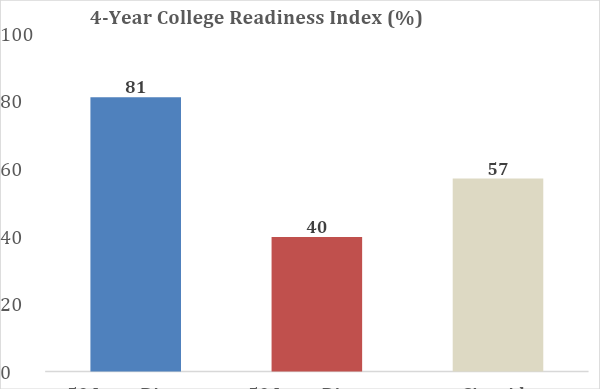
Increasing diversity in the hyper-segregated Black and Latinx schools
Past educational policies have not weakened the strong link between demography and destiny. The zip codes of the city’s families, most decisively the city’s Black and Latinx families, still determine the quality of education their students receive. A complex pattern of inequities in land ownership, housing finance, mortgaging practices and residential zoning has produced the neighborhood segregation that underlies the hyper-segregation of the least diverse Black and Latinx high schools. Though our previous blog’s proposals would substantially diversify the city’s predominantly White and Asian schools, those proposals will not reduce segregation in the fifty least diverse Black and Latinx schools because there are not enough White and Asian students to diversify all the city’s high schools. Until the city’s deep structure of institutional racism is uprooted, reducing hyper-segregation in the city’s high schools must focus on improving the quality of teaching and learning in those schools. What follows are some policy proposals that suggest what the mayor needs to do.
Improving instruction
Improving the least diverse high schools’ quality of instruction requires recruiting, training, and supporting a huge increase in effective Black and Latinx teachers. The hyper-segregated Black and Latinx high schools need teachers who understand their students’ histories, cultural backgrounds, languages, and daily struggles, and are committed to improving and nurturing their students’ skills, capacities, and futures. Recent research has demonstrated the added value that teachers of color bring to their students and schools. City leaders should mobilize the city’s public and private higher education institutions to develop and fund a massive recruiting and teacher preparation program–a mini-Marshall Plan–that triples the city’s current Black and Latinx high school teacher cohort. A key target of this recruitment effort should be potential male teachers of color.
Since most of those newly recruited teachers will be young and inexperienced, the least diverse Black and Latinx high schools will need a cohort of lead teachers to train, guide, mentor, and support the new entrants and help them consolidate collaborative teaching teams in their schools. The lead teachers should be recruited from all the city’s high schools and receive a considerable bonus to commit themselves to their new schools for at least five years. Lead teacher recruitment from existing high schools should be capped to ensure that no school loses an excess of experienced teachers
Improving supports and services
Community School status should be expanded to all fifty of the least diverse Black and Latinx high schools. Community schools collaborate with local organizations to meet school and community needs: they provide after-school programs offering arts, sports, homework help, tutoring, and mentoring; health care including vision, dental, socio-emotional, and mental health services; family engagement, and adult education. Much research, including a recent Rand Corporation study, documents clear gains in student achievement in NYC schools featuring varieties of community school efforts.
Yet only 19 of the 50 hyper-segregated high schools were given community school status by the de Blasio administration. If instead of tackling the underlying causes of segregation, our city persists in assigning thousands of students to these hyper-segregated schools, it should provide the best teachers and the most comprehensive supports possible. We recommend that all fifty of the least diverse Black and Latinx high schools be awarded Community School status.
Improving college access
The College Readiness Index (CRI) suggests that these hyper-segregated schools send very few of their students to college. Yet the city’s higher education institutes and non-profit groups have developed varieties of bridge-to-college programs to support first-generation college students. The City University of New York (CUNY) has several such programs including College Now, which for 40 years has been recruiting high school juniors and seniors into credit-bearing CUNY courses provided on-site, and free, at their local high schools. We recommend that CUNY’s College Now program make linkages with all fifty of the least diverse Black and Latinx schools.
College Access: Research & Action (CARA) has developed a school-wide model which works intensively with high schools to build effective college-going cultures. CARA integrates post-secondary exploration into students’ schedules and provides targeted coaching and teacher development. By training peer mentors recruited from local schools and communities, CARA provides culturally responsive counseling throughout the college application process. We recommend incorporating CARA’s programs or similar college-bound supports into each of the fifty least diverse Black and Latinx schools.
What else is needed?
Improving instruction, student supports and services, and college access are only initial suggestions for how to improve instruction, opportunities, and academic outcomes for the students in these hyper-segregated high schools. These schools also need talented, committed, and effective leadership, an intensive focus on on-track performance, beginning in 9th grade, as pioneered by the University of Chicago Consortium on School Reform, as well as the student progress analysis integrated into the DataCation platform that New Visions for Public Schools has developed. They also need intensive individualized tutoring programs; recent research from Brown University and the Education Lab at Saga/Match indicate such interventions yield substantial gains in student achievement.
Student capacity in these hyper-segregated high schools has been massively stunted because these schools have been under-served, poorly staffed, and under-resourced for decades. Given the devastation wreaked by the pandemic, these schools need a huge additional investment in instruction and supportive services so that all their students graduate high school ready to succeed in college, just as the graduates in the fifty least diverse White and Asian high schools do.
Christina Mokhtar-Ross, Ph.D., Independent Education Research Scholar, formerly at the Annenberg Institute for School Reform and the Department of Social Policy, University of Oxford


